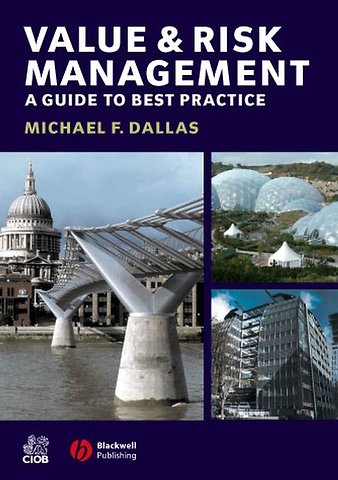Value and Risk Management – A Guide to Best Practice
A Guide to Best Practice
Paperback Engels 2006 9781405120692Samenvatting
Published on behalf of the Chartered Institute of Building and endorsed by a range of construction industry institutes, this book explains the underlying concepts of value and risk, and how they relate to one another. It describes the different issues to be addressed in a variety of circumstances and at all stages of a project′s life and reviews a number of commonly used and effective techniques, showing how these may be adapted to suit individuals′ styles and circumstances.
∗ Published on behalf of the Chartered Institute of Building with cross–industry institutional support
∗ Combines value and risk management which are often considered, wrongly, in isolation
∗ Makes a complicated subject accessible to a wide audience of construction practitioners
∗ Features checklists and proformas to aid implementation of best practice
∗ Author has extensive practical experience of the subject
Specificaties
Lezersrecensies
Inhoudsopgave
<p>Preface xiii</p>
<p>About the Author xvii</p>
<p>Acknowledgements xviii</p>
<p>1 Key features and benefits 1</p>
<p>1.1 Why successful projects need value and risk management 1</p>
<p>1.2 Delivering success 1</p>
<p>1.3 Summary 7</p>
<p>2 Principles of value management 9</p>
<p>2.1 Essential attributes 10</p>
<p>2.2 A brief history 11</p>
<p>2.3 Language 13</p>
<p>2.4 Concepts 13</p>
<p>2.5 The family 15</p>
<p>2.6 Value management through the project cycle 17</p>
<p>2.7 The generic process 19</p>
<p>2.8 Value or cost balancing benefits and investment 22</p>
<p>2.9 The value of time 25</p>
<p>2.10 Quality 26</p>
<p>2.11 Measuring value 29</p>
<p>3 Principles of risk management 33</p>
<p>3.1 Essential attributes 34</p>
<p>3.2 Evolution 35</p>
<p>3.3 Language 37</p>
<p>3.4 Concepts 37</p>
<p>3.5 The family 40</p>
<p>3.6 Risk management cycle 41</p>
<p>3.7 A generic risk management process 41</p>
<p>3.8 Risk to quality 43</p>
<p>3.9 Measuring risk 44</p>
<p>3.10 Contingency management 49</p>
<p>3.11 Time risk 49</p>
<p>4 An integrated approach to value and risk management 52</p>
<p>4.1 Why integrate? 53</p>
<p>4.2 The integrated process 57</p>
<p>4.3 Timing 58</p>
<p>4.4 Project stages and study types 61</p>
<p>4.5 Understanding the client s business 66</p>
<p>4.6 Programmes of projects 69</p>
<p>4.7 Project launch studies 70</p>
<p>4.8 Summary of value and risk study types 72</p>
<p>4.9 Critical success factors 76</p>
<p>4.10 A framework for introducing value and risk management into an organisation 77</p>
<p>4.11 Embedding value and risk management in an organisation 81</p>
<p>4.12 Drawing on experience 83</p>
<p>4.13 Selecting the appropriate level of activity 86</p>
<p>5 People 88</p>
<p>5.1 The people and their roles 89</p>
<p>5.2 Collaboration versus confrontation 89</p>
<p>5.3 Stakeholder analysis and management 91</p>
<p>5.4 Team building 92</p>
<p>5.5 Partnering 92</p>
<p>5.6 Communications 95</p>
<p>5.7 The supply chain 97</p>
<p>5.8 Selecting the study team 100</p>
<p>5.9 The study leader 103</p>
<p>5.10 Styles of leadership 105</p>
<p>5.11 A study structure based on logic 105</p>
<p>5.12 Overcoming difficulties 107</p>
<p>5.13 Using conflict to advantage 110</p>
<p>5.14 Gaining consensus 111</p>
<p>5.15 Developing value and risk culture 112</p>
<p>5.16 Language 114</p>
<p>6 Concepts, standards and qualifications 117</p>
<p>6.1 Understanding value and risk 118</p>
<p>6.2 Understanding value 119</p>
<p>6.3 Understanding risk 140</p>
<p>6.4 Training and certification systems 150</p>
<p>7 Learning from others 154</p>
<p>7.1 Practice in other sectors 154</p>
<p>7.2 A value and risk approach to project development 155</p>
<p>7.3 Soft value management 161</p>
<p>7.4 Value management in manufacturing 164</p>
<p>7.5 Value management for public services 168</p>
<p>7.6 Risk and enterprise 174</p>
<p>7.7 The impact of partnering on value and risk 183</p>
<p>7.8 Just how mature are your organisation s processes? 188</p>
<p>8 Study types 193</p>
<p>8.1 Types of study 194</p>
<p>8.2 Value management studies 194</p>
<p>8.3 Risk management studies 218</p>
<p>8.4 Combining value and risk reviews 226</p>
<p>8.5 Project reviews 227</p>
<p>8.6 European practice 230</p>
<p>8.7 The project cycle 230</p>
<p>8.8 Building on experience 231</p>
<p>9 Techniques for value and risk 234</p>
<p>9.1 The need for techniques 235</p>
<p>9.2 Preparation before a study 235</p>
<p>9.3 Invitation to participate 244</p>
<p>9.4 The workshop 245</p>
<p>9.5 Recording 250</p>
<p>9.6 The wrap–up meeting 250</p>
<p>9.7 Reporting 251</p>
<p>9.8 Reviewing progress 252</p>
<p>9.9 Whole–life costing 254</p>
<p>9.10 Stakeholder analysis 259</p>
<p>9.11 Partnering 263</p>
<p>9.12 Mind mapping 269</p>
<p>9.13 The Delphi technique 269</p>
<p>10 Value management techniques 271</p>
<p>10.1 Value management techniques 271</p>
<p>10.2 Function analysis 272</p>
<p>10.3 Function analysis system technique 274</p>
<p>10.4 Cost/worth 282</p>
<p>10.5 Multifunctionality 284</p>
<p>10.6 SMART methodology 285</p>
<p>10.7 Value drivers 287</p>
<p>10.8 Value profiling (or value benchmarking) 291</p>
<p>10.9 Option selection 292</p>
<p>10.10 Weighting techniques 293</p>
<p>10.11 Generating ideas for adding value (creative techniques) 295</p>
<p>10.12 Selecting the best ideas (evaluation) 300</p>
<p>10.13 Developing implementation proposals 305</p>
<p>10.14 Scenarios 306</p>
<p>10.15 Target costing 307</p>
<p>10.16 Function performance specification 308</p>
<p>11 Risk management techniques 311</p>
<p>11.1 Risk management techniques 311</p>
<p>11.2 Risk analysis and management 311</p>
<p>11.3 Identifying risks 314</p>
<p>11.4 Assessing risk 319</p>
<p>11.5 Managing risk 326</p>
<p>11.6 Optimism bias 335</p>
<p>11.7 Construction, design and management regulations 338</p>
<p>11.8 Risk breakdown structures 338</p>
<p>11.9 Failure modes and effects analysis 340</p>
<p>11.10 Hazard and operational studies (HAZOP) 341</p>
<p>12 Toolbox checklists, forms and tables 343</p>
<p>12.1 Toolbox summary 343</p>
<p>12.2 Briefing checklist 343</p>
<p>12.3 Information checklist 344</p>
<p>12.4 Study toolkit 345</p>
<p>12.5 Workshop invitation 346</p>
<p>12.6 Recording information generated during the workshop 346</p>
<p>12.7 Reports 348</p>
<p>12.8 Value management categories/prompt list 349</p>
<p>12.9 Risk identification prompt list 351</p>
<p>12.10 Value profiling proforma 354</p>
<p>12.11 Option evaluation matrix 355</p>
<p>12.12 Weighting tool 355</p>
<p>12.13 Paired comparison proforma 355</p>
<p>12.14 Proforma for whole–life cost estimating 356</p>
<p>12.15 Scenario building form 357</p>
<p>12.16 Whole–life cost checklist 357</p>
<p>12.17 HAZOP analysis sheet 357</p>
<p>12.18 Room layouts 358</p>
<p>Appendix A: Bibliography 362</p>
<p>Appendix B: Glossary 365</p>
<p>Index 376</p>
Rubrieken
- advisering
- algemeen management
- coaching en trainen
- communicatie en media
- economie
- financieel management
- inkoop en logistiek
- internet en social media
- it-management / ict
- juridisch
- leiderschap
- marketing
- mens en maatschappij
- non-profit
- ondernemen
- organisatiekunde
- personal finance
- personeelsmanagement
- persoonlijke effectiviteit
- projectmanagement
- psychologie
- reclame en verkoop
- strategisch management
- verandermanagement
- werk en loopbaan

